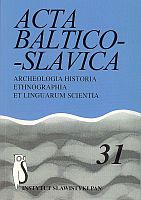Język polski na Białorusi Wschodniej. Sytuacja socjolingwistyczna i uwagi o mowie wsi Stajsk i Wesołowo
Polish language in the East Belarus. The socjolinguistic situation and remarks about language of Stajsk and Vesolovo
Author(s): Małgorzata Ostrówka, Mirosław JankowiakSubject(s): Language and Literature Studies
Published by: Instytut Slawistyki Polskiej Akademii Nauk
Keywords: Belarus; Stajsk; Wesołowo; the sociolinguistic situation; Polish dialect
Summary/Abstract: Stajsk and Wesołowo are villages mainly inhabited by the Poles. They came into being as a result of the most later migration of the Polish country-folk at the beginning of the XX century. Polish peasants came to Belarus from the provinces of Radom, Kalisz, Piotrków, Lublin and Siedlce. In the interwar period the language used at homes and the language of prayer in every Polish family was a dialect brought from Polish ethnic territories. They talked in Belarusian with their Belarusian neighbours (in a local dialect). After the World War II disintegration of the Polish community occurred - the children and grandchildren of our informants attended Russian and Belarusian schools, mixed marriages were more and more common. This resulted in the disconnection of Polish continuum in the middle generation – the grandchildren and great-grandchildren of our informants know the speech of their forefathers only passively. They are usually Russian-speaking. In the sphere of the sacred there are two languages used – the personal prayer and the confession in Polish, the service is officiated in Belarusian (by the priests from Poland). The Poles communicate in the local Belarusian dialect with their neighbours – Belarusians. The Polish language of our informants remains a well preserved dialect brought from the ethnic territories. It is confirmed by numerous phonetic or morphological features and the vocabulary. As far as the phonetic features are concerned these are: the labialization of the vowels o and u; the narrowing o>ó: the remains of the existence of oblique a – āN > u: śpievumy; the narrowing of the oblique q > o; the narrowing of oblique e ė > i/y; the remains of pronouncing alveolar consonants as dental ones duzo, scypek, cforo,; the remains of preserving the hard l: xlyp, f cybuly.. The Poles from Stajsk and Wesołowo possessed a variety of East Slavic features, e.g.: soft l’, voiced h: prohrama, hektar; pronouncing – a in the place of -o and the lexicon concerning the soviet reality and economy: kołchoz, swochoz, sielsawiet; the everyday life: duxofka, davleńe, balńica, etc.
Journal: Acta Baltico Slavica
- Issue Year: 2007
- Issue No: 31
- Page Range: 175-198
- Page Count: 24
- Language: Polish

